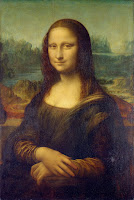These are notes for my online discussion with Georgian Student Parliament on Tuesday 7 December, 2021, organized by Nina Tsatsanashvili. All photos in this post are from Wikipedia.
If you look up the word "structure" on the Google Dictionary, you will find the following definition: the arrangement of and relations between the parts or elements of something complex. When the "parts or elements" are subject to specific interpretation, we have at hand an "abstract structure". For example, consider a painting, which can be seen as an arrangement of colors. For instance, Leonardo da Vinci's Mona Lisa:
In this sense, abstract mathematics is similar to composition in music: in both cases one builds structures that are inherently abstract. The analogy goes further: a musical performer can be compared to an engineer, for instance, who produces concrete structures by means of concrete interpretations of the abstract mathematical structures.
As an example of a form of abstract structure in mathematics, consider the following diagram:
This diagram displays two mathematical structures, given by Fig. A and Fig. B. Each of them are abstract structures in the sense that the points and the arrows in each structure are subject to interpretation. The two structures have a similar form: they are both made out of points and arrows. Such structures in mathematics are called directed graphs. A mathematical theory that explores various different types of graphs and their interrelation is called graph theory. Graph theory, however, is not only about directed graphs. Other mathematical structures are also part of the theory, such as natural numbers, for instance. They arise by counting various different phenomena dealing with graphs: for example, by counting how many trajectories connect one point of the graph with another. Similarly, in a single musical composition, there is one (or several) main forms of musical structure, whose different manifestations are being explored, along with their interrelations, in the composition. What is the main form of musical structure in Für Elise?



0 Comments:
Post a Comment